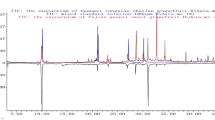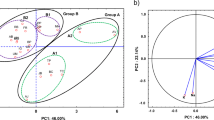Abstract
A previously fully validated method using high-performance liquid chromatography with diode array detection (HPLC-DAD) was applied to determine 12 bioactive phenolic compounds in 9 different fruits consumed in Salvador, Bahia, Brazil. A central composite design (CCD) was employed to investigate the effects of independent variables in the extraction method for spectrophotometric determinations. The model showed a good correlation between the predicted and experimental values. The results indicate that the fruits are rich in polyphenols, mainly ellagic acid, vanillic acid, rutin and quercetin. Total polyphenol content (TPC), total flavonoid content (TFC), total anthocyanin content (TAC), and antioxidant capacity were also determined by DPPH assay and can be related to the diverse range of phenolics detected. Kohonen Self- Organizing Map (SOM) Artificial Neural Network was applied for more insights about cluster separation and the influence of each variable considering one of its main characteristics related to the treatment of non-linear data. A true classification model partial least squares-discriminant analysis (PLS-DA) and multilayer perceptron (MLP) artificial neural network were applied to the current samples, and while MLP proved to be a suitable technique for the classification of different fruits evaluated in this study, PLS-DA obtained a very large experimental error due to the similarities of the experimental data and also due to the existence of non-linear relationships between the variables.



Similar content being viewed by others
References
Abdi H (2010) Partial least squares regression and projection on latent structure regression (PLS regression), Wiley Interdiscip. Rev Comput Stat 2:97–106. https://doi.org/10.1002/wics.51
Ajila CM, Prasada Rao UJS (2013) Mango peel dietary fibre: composition and associated bound phenolics. J Funct Foods 5:444–450. https://doi.org/10.1016/j.jff.2012.11.017
Aloglu AK, Harrington PB, Sahin S, Demir C (2016) Prediction of total antioxidant activity of Prunella l. species by automatic partial least square regression applied to 2-way liquid chromatographic UV spectral images. Talanta. 161:503–510. https://doi.org/10.1016/j.talanta.2016.09.014
Batista ÂG, da Silva JK, Cazarin CBB, Biasoto ACT, Sawaya ACHF, Prado MA, Maróstica Júnior MR (2017) Red-jambo (Syzygium malaccense): bioactive compounds in fruits and leaves. LWT Food Sci Technol 76:284–291. https://doi.org/10.1016/j.lwt.2016.05.013
Betancourth JM, Cuellar M, Ortiz PI, Pfaffen V (2018) Multivariate cathodic square wave stripping voltammetry optimization for nitro group compounds determination using antimony film electrodes. Microchem J 139:139–149. https://doi.org/10.1016/j.microc.2018.02.028
Borges CV, Amorim VBO, Ramlov F, Ledo CAS, Donato M, Maraschin M, Amorim EP (2014) Characterisation of metabolic profile of banana genotypes, aiming at biofortified Musa spp. cultivars. Food Chem 145:496–504. https://doi.org/10.1016/j.foodchem.2013.08.041
Brand-Williams W, Cuvelier ME, Berset C (1995) Use of a free radical method to evaluate antioxidant activity. LWT Food Sci Technol 28:25–30. https://doi.org/10.1016/S0023-6438(95)80008-5
Carter S, Fisher A, Gibson B, Marshall J, Russell B, Whiteside I (2017) Atomic spectrometry update: review of advances in the analysis of metals, chemicals and materials. J Anal Atom Spectrom 32:2068–2117. https://doi.org/10.1039/C7JA90046E
da Silva LMR, de Figueiredo EAT, Ricardo NMPS, Vieira IGP, de Figueiredo RW, Brasil IM, Gomes CL (2014) Quantification of bioactive compounds in pulps and by-products of tropical fruits from Brazil. Food Chem 143:398–404. https://doi.org/10.1016/j.foodchem.2013.08.001
Davies DL, Bouldin DW (1979) A cluster separation measure. IEEE Trans Pattern Anal Mach Intell 1:224–227. https://doi.org/10.1109/TPAMI.1979.4766909
de Assis SA, Vellosa JC, Brunetti IL, Khalil NM, Leite KM, Martins AB, Oliveira OM (2009) Antioxidant activity, ascorbic acid and total phenol of exotic fruits occurring in Brazil. Int J Food Sci Nutr 60:439–448. https://doi.org/10.1080/09637480701780641
de Lima VLAG, Mélo EA, Maciel MIS, Lima DES (2003) Evaluation of total anthocyanins in frozen acerola pulp from fruits of 12 different acerola trees (Malpighia emarginata D.C.). Food Sci Technol 23:101–103. https://doi.org/10.1590/S0101-20612003000100021
dos Santos WNL, Sauthier MCS, Cavalcante DD, Benevides CMJ, Dias FS, Santos DCMB (2016) Mineral composition, nutritional properties, total phenolics and flavonoids compounds of the atemoya fruit (Annona squamosa L. x Annona cherimola mill.) and evaluation using multivariate analysis techniques. An Acad Bras Cienc 88:1243–1252. https://doi.org/10.1590/0001-3765201620150537
dos Santos WNL, Sauthier MCS, dos Santos AMP, Santana DA, Azevedo RSA, Caldas JC (2017a) Simultaneous determination of 13 phenolic bioactive compounds in guava (Psidium guajava L.) by HPLC-PAD with evaluation using PCA and artificial neural network (ANN). Microchem J 133:583–592. https://doi.org/10.1016/j.microc.2017.04.029
dos Santos WNL, Santos Júnior AFS, Silva LOB, Santos BRS, da Silva DLF (2017b) Multivariate optimization of a digestion procedure for bismuth determination in urine using continuous flow hydride generation and atomic fluorescence spectrometry. Microchem J 130:147–152. https://doi.org/10.1016/j.microc.2016.07.023
dos Santos AMP, Silva EFR, dos Santos WNL, da Silva EGP, dos Santos LO, Santos BRS, Sauthier MCS, dos Santos WPC (2018) Evaluation of minerals, toxic elements and bioactive compounds in rose petals (Rosa spp.) using chemometric tools and artificial neural networks. Microchem J 138:98–108. https://doi.org/10.1016/j.microc.2017.12.018
Engel I, Bershad NJ (1994) A transient learning comparison of Rosenblatt, mackpropagation, and LMS algorithms for a single-layer perceptron for system identification. IEEE Trans Signal Process 42 1247–1251. https://doi.org/10.1109/78.295190
Erdman J, Oria M, Pillsbury L (2011) Nutrition and traumatic brain injury: improving acute and subacute health outcomes in military personnel. National Academies Press, Washington
Etchepare MA, de Menezes MFSC, Rodrigues LZ, Codevilla CF, de Menezes CR (2015) Microencapsulation of bioactive compounds by extrusion method. Ciência e Natura 37:97–105. https://doi.org/10.5902/2179-460X19725
Faggio C, Sureda A, Morabito S, Sanches-Silva A, Mocan A, Nabavi SF, Nabavi SM (2017) Flavonoids and platelet aggregation: a brief review. Eur J Pharmacol 807:91–101. https://doi.org/10.1016/j.ejphar.2017.04.009
Ferreira ALA, Matsubara LS (1997) Radicais livres: conceitos, doenças relacionadas, sistema de defesa e estresse oxidativo. Rev Ass Med Bras 43:61–68. https://doi.org/10.1590/S0104-42301997000100014
Fu X, Cheng S, Liao Y, Huang B, Du B, Zeng W, Jiang Y, Duan X, Yang Z (2018) Comparative analysis of pigments in red and yellow banana fruit. Food Chem 239:1009–1018. https://doi.org/10.1016/j.foodchem.2017.07.046
Giusti MM, Wrolstad RE (2001) Anthocyanins. characterization and measurement by UV-visible spectroscopy. Curr Protoc in Food Anal Chem. https://doi.org/10.1002/0471142913.faf0102s00
Gobbo-Neto L, Lopes NP (2007) Medicinal plants: factors of influence on the content of secondary metabolites. Quim Nova 30:374–381. https://doi.org/10.1590/S0100-40422007000200026
Helland IS (1988) On the structure of partial least squares regression. Commun Stat-Simul Comput 17:581–607. https://doi.org/10.1080/03610918808812681
Helrick K (2000) Official methods of analysis. AOAC
Inbaraj BS, Lu H, Kao TH, Chen BH (2010) Simultaneous determination of phenolic acids and flavonoids in Lycium barbarum Linnaeus by HPLC-DAD-ESI-MS. J Pharm Biomed Anal 51:549–556. https://doi.org/10.1016/j.jpba.2009.09.006
Johnson GW, Ehrlich R (2002) State of the art report on multivariate chemometric methods in environmental forensics. Environ Forensic 3(1):59–79. https://doi.org/10.1080/713848317
Karsoliya S, (2012) Approximating number of hidden layer neurons in multiple hidden layer BPNN Architecture, 3 714–717
Karunanithi BN, Grenney WJ, Whitley D, Bovee K (1994) Neural network for river flow prediction. J Comput Civ Eng 8:201–220
Lobo V, Patil A, Phatak A, Chandra N (2010) Free radicals, antioxidants and functional foods: impact on human health. Pharmacogn Rev 4:118–126. https://doi.org/10.4103/0973-7847.70902
Marques TR, Caetano AA, Simão AA, Castro FCO, Ramos VO, Corrêa AD (2016) Metanolic extract of Malpighia emarginata bagasse: phenolic compounds and inhibitory potential on digestive enzymes. Braz J Pharm Sci 26:191–196. https://doi.org/10.1016/j.bjp.2015.08.015
Mezadri T, Villaño D, Fernández-Pachón MS, García-Parrilla MC, Troncoso AM (2008) Antioxidant compounds and antioxidant activity in acerola (Malpighia emarginata DC.) fruits and derivatives. J Food Compos Anal 21:282–290. https://doi.org/10.1016/j.jfca.2008.02.002
Musa KH, Abdullah A, Al-Haiqi A (2016) Determination of DPPH free radical scavenging activity: application of artificial neural networks. Food Chem 194:705–711. https://doi.org/10.1016/j.foodchem.2015.08.038
Oliveira GKF, Tormin TF, Sousa RMF, de Oliveira A, de Morais SAL, Richter EM, Munoz RAA (2016) Batch-injection analysis with amperometric detection of the DPPH radical for evaluation of antioxidant capacity. Food Chem 192:691–697. https://doi.org/10.1016/j.foodchem.2015.07.064
Oliveri P (2017) Class-modelling in food analytical chemistry: development, sampling, optimisation and validation issues – a tutorial. Anal Chim Acta 982:9–19. https://doi.org/10.1016/j.aca.2017.05.013
Olivieri AC (2014) Analytical figures of merit: from univariate to multiway calibration. Chem Rev 114:5358–5378. https://doi.org/10.1021/cr400455s
Rababah TM, Al-Mahasneh MA, Kilani I, Yang W, Alhamad MN, Ereifej K, Al-U'datt M (2011) Effect of jam processing and storage on total phenolics, antioxidant activity, and anthocyanins of different fruits. J Sci Food Agric 91:1096–1102. https://doi.org/10.1002/jsfa.4289
Rahman MS, Rashid MM, Hussain MA (2012) Thermal conductivity prediction of foods by neural network and fuzzy (ANFIS) modeling techniques. Food Bioprod Process 90:333–340. https://doi.org/10.1016/j.fbp.2011.07.001
Rännar S, Lindgren F, Geladi P, Wold S (1994) A PLS kernel algorithm for data sets with many variables and fewer objects. Part 1: theory and algorithm. J Chemom 8:111–125. https://doi.org/10.1002/cem.1180080204
Rêgo Júnior NO, Fernandez LG, de Castro RD, Silva LC, Gualberto SA, Pereira MLA, da Silva MV (2011) Bioactive compounds and antioxidant activity of crude extracts of brushwood vegetable species. Braz J Food Technol 14:50–57. https://doi.org/10.4260/BJFT2011140100007
Saric S, Clark AK, Sivamani RK, Lio PA, Lev-Tov HA (2017) The role of polyphenols in rosacea treatment: a systematic review. J Altern Complement Med 23:920–929. https://doi.org/10.1089/acm.2016.0398
Sauthier MCS, da Silva EGP, Santos BRS, Silva EFR, Caldas JC, Minho LAC, dos Santos AMP, dos Santos WNL (2019) Screening of Mangifera indica L. functional content using PCA and neural networks (ANN). Food Chem 273:115–123. https://doi.org/10.1016/j.foodchem.2018.01.129
Singh KP, Basant A, Malik A, Jain G (2009) Artificial neural network modeling of the river water quality — A case study. Ecol Model 220:888–895. https://doi.org/10.1016/j.ecolmodel.2009.01.004
Sinkov NA, Johnston BM, Sandercock PML, Harynuk JJ (2011) Automated optimization and construction of chemometric models based on highly variable raw chromatographic data. Anal Chim Acta 697:8–15. https://doi.org/10.1016/j.aca.2011.04.029
Soares ER, Monteiro EB, da Silva RC, Batista A, Sobreira F, Mattos T, da Costa CA, Daleprane JB (2015) Compostos bioativos em alimentos, estresse oxidativo e inflamação: uma visão molecular da nutrição. Rev Hosp Univ Pedro Ernesto 14:64–72. https://doi.org/10.12957/rhupe.2015.19942
Sochor J, Zitka O, Skutkova H, Pavlik D, Babula P, Krska B, Horna A, Adam V, Provaznik I, Kizek R (2010) Content of phenolic compounds and antioxidant capacity in fruits of apricot genotypes. Molecules 15:6285–6305. https://doi.org/10.3390/molecules15096285
TACO (2011) Brazilian table of food composition, 4th edn. NEPA – UNICAMP, Campinas. http://www.agricultura.gov.br/assuntos/inspecao/produtos-vegetal/legislacao-1/biblioteca-de-normas-vinhos-e-bebidas/tabela-brasileira-decomposicao-de-alimetos_taco_2011.pdf
Tsamo CVP, Herent MF, Tomekpe K, Emaga TH, Quetin-Leclercq J, Rogez H, Larondelle Y, Andre C (2015) Phenolic profiling in the pulp and peel of nine plantain cultivars (Musa sp.). Food Chem 167:197–204. https://doi.org/10.1016/j.foodchem.2014.06.095
Vial J, Noçairi H, Sassiat P, Mallipatu S, Cognon G, Thiébaut D, Teillet B, Rutledge DN (2009) Combination of dynamic time warping and multivariate analysis for the comparison of comprehensive two-dimensional gas chromatograms. Application to plant extracts. J Chromatogr A 1216:2866–2872. https://doi.org/10.1016/j.chroma.2008.09.027
Zhang Q, Chen W, Zhao J, Xi W (2016) Functional constituents and antioxidant activities of eight Chinese native goji genotypes. Food Chem 200:230–236. https://doi.org/10.1016/j.foodchem.2016.01.046
Funding
The authors are grateful to the Brazilian Agency, to the Fundação de Amparo à Pesquisa do Estado da Bahia (FAPESB), Conselho Nacional de Desenvolvimento Científico e Tecnológico (CNPq), and Programa de Apoio a Núcleos de Excelência (PRONEX) by the grants and fellowships. This study was financed in part by the Coordenação de Aperfeiçoamento de Pessoal de Nível Superior - Brasil (CAPES) - Finance Code 001.
Author information
Authors and Affiliations
Corresponding author
Ethics declarations
Conflict of Interest
Bruna Rosa da Silva Santos declares that she has no conflict of interest. Lucas Almir Cavalcante Minho that he has no conflict of interest. Emmanuelle Ferreira Requião Silva that she has no conflict of interest. Maria Celeste da Silva Sauthier that she has no conflict of interest. Jamile da Cruz Caldas that she has no conflict of interest. Erik Galvão Paranhos da Silva that he has no conflict of interest. Débora de Andrade Santana that she has no conflict of interest. Walter Nei Lopes dos Santos that she has no conflict of interest.
Ethical Approval
Consent not applicable because this article does not contain any studies with human participants or animals performed by any of the authors.
Additional information
Publisher’s Note
Springer Nature remains neutral with regard to jurisdictional claims in published maps and institutional affiliations.
Rights and permissions
About this article
Cite this article
da Silva Santos, B.R., Minho, L.A.C., Silva, E.F.R. et al. Chemometric Tools Applied to Evaluation of Fruit Bioactive Compounds Extraction. Food Anal. Methods 13, 1176–1189 (2020). https://doi.org/10.1007/s12161-020-01728-0
Received:
Accepted:
Published:
Issue Date:
DOI: https://doi.org/10.1007/s12161-020-01728-0




